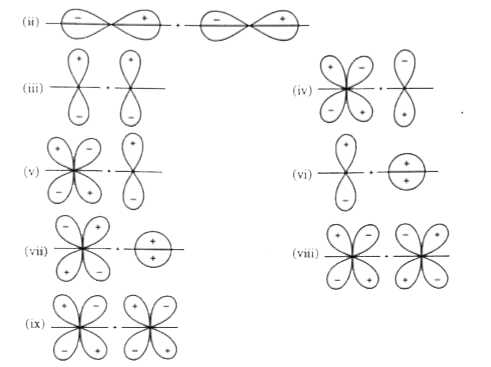Which molecular orbital is form by positive overlapping of





The correct Answer is:C
Topper's Solved these Questions
- CHEMICAL BONDING AND MOLECULAR STRUCTUREBOOK - KUMAR PRAKASHANCHAPTER - CHEMICAL BONDING AND MOLECULAR STRUCTUREEXERCISE - SECTION - C (MCQs ASKED IN COMPETITIVE EXAM)
17 Videos
- CHEMICAL BONDING AND MOLECULAR STRUCTUREBOOK - KUMAR PRAKASHANCHAPTER - CHEMICAL BONDING AND MOLECULAR STRUCTUREEXERCISE - SECTION - C (ASSERTION AND REASON TYPE QUESTIONS)
4 Videos
- CHEMICAL BONDING AND MOLECULAR STRUCTUREBOOK - KUMAR PRAKASHANCHAPTER - CHEMICAL BONDING AND MOLECULAR STRUCTUREEXERCISE - SECTION - B (OBJECTIVE QUESTIONS)
107 Videos
- CLASSIFICATION OF ELEMENTS AND PERIODICITY IN PROPERTIES BOOK - KUMAR PRAKASHANCHAPTER - CLASSIFICATION OF ELEMENTS AND PERIODICITY IN PROPERTIES EXERCISE - Section -D SOLUTIONS OF NCERT EXEMPLAR PROBLEMS (Long Answer Type Questions )
7 Videos
Similar Questions
Sketch the shapes of the molecular orbitals formed by the overlap of (a) s-orbitals (b) end on overlap of two p-orbitals (c) side wise overlap of two p-orbitals. Name the orbitals formed in each case.
View SolutionA π-molecular orbital is formed by the ............ overlapping of atomic orbitals.
View Solution
Knowledge Check
If Z−aξs is the molecular axis, then π−molecular orbitals are formation by the formed by the overlap of
As+pzBpx+pyCpz+pzDpx+pxIf x-axis is the molecular axis, the π-molecular orbitals are formed by the overlap of
As+pzBPx+PyCPz+PzDPx+PxAccording to MOT, two atomic orbitals overlap resulting in the formation of molecular orbital formed. Number of atomic orbitals overlapping together is equal to the molecule orbital formed. The two atomic orbital thus formed by LCAO (linear combination of atomic orbital) in the phase or in the different phase are known as bonding and antibonding molecular orbitals respectively. The energy of bonding molecular orbital is lower than that of the pure atomic orbitals by an amount Δ. This known as the stabilization energy. The enerby of antibonding molecular orbital in increased by Δ' (destabilisation energy).
Q. If x-axis is the molecular axis, then π-moleulcar orbitals are formed by the overlap of :AS+pxBpx+pyCPz+pzDpx+px
According to MOT, two atomic orbitals overlap resulting in the formation of molecular orbital formed. Number of atomic orbitals overlapping together is equal to the molecule orbital formed. The two atomic orbital thus formed by LCAO (linear combination of atomic orbital) in the phase or in the different phase are known as bonding and antibonding molecular orbitals respectively. The energy of bonding molecular orbital is lower than that of the pure atomic orbitals by an amount Δ. This known as the stabilization energy. The enerby of antibonding molecular orbital in increased by Δ' (destabilisation energy).
Q. If x-axis is the molecular axis, then π-moleulcar orbitals are formed by the overlap of :
View SolutionThere are some arrangements of atomic orbitals which are given below:

 Then calculate the value of "QtimesR-P'" where P, Q and R are no. of arrangements which give bonding molecular orbitals (positive overlap), antibonding molecular orbitals (negative overlap) and non-bonding molecular orbitals (zero overlap) respectively.
Then calculate the value of "QtimesR-P'" where P, Q and R are no. of arrangements which give bonding molecular orbitals (positive overlap), antibonding molecular orbitals (negative overlap) and non-bonding molecular orbitals (zero overlap) respectively.
View SolutionThe possible molecular orbital formed when two d-orbitals overlap is .
View SolutionAccording to MOT, two atomic orbitals overlap resulting in the formation of molecular orbital formed. Number of atomic orbitals overlapping together is equal to the molecule orbital formed. The two atomic orbital thus formed by LCAO (linear combination of atomic orbital) in the phase or in the different phase are known as bonding and antibonding molecular orbitals respectively. The energy of bonding molecular orbital is lower than that of the pure atomic orbitals by an amount Δ. This known as the stabilization energy. The enerby of antibonding molecular orbital in increased by Δ' (destabilisation energy).
Q. If x-axis is the molecular axis, then π-moleulcar orbitals are formed by the overlap of :
View SolutionThe possible molecular orbital formed when two d-orbitals overlap is .
View Solution
